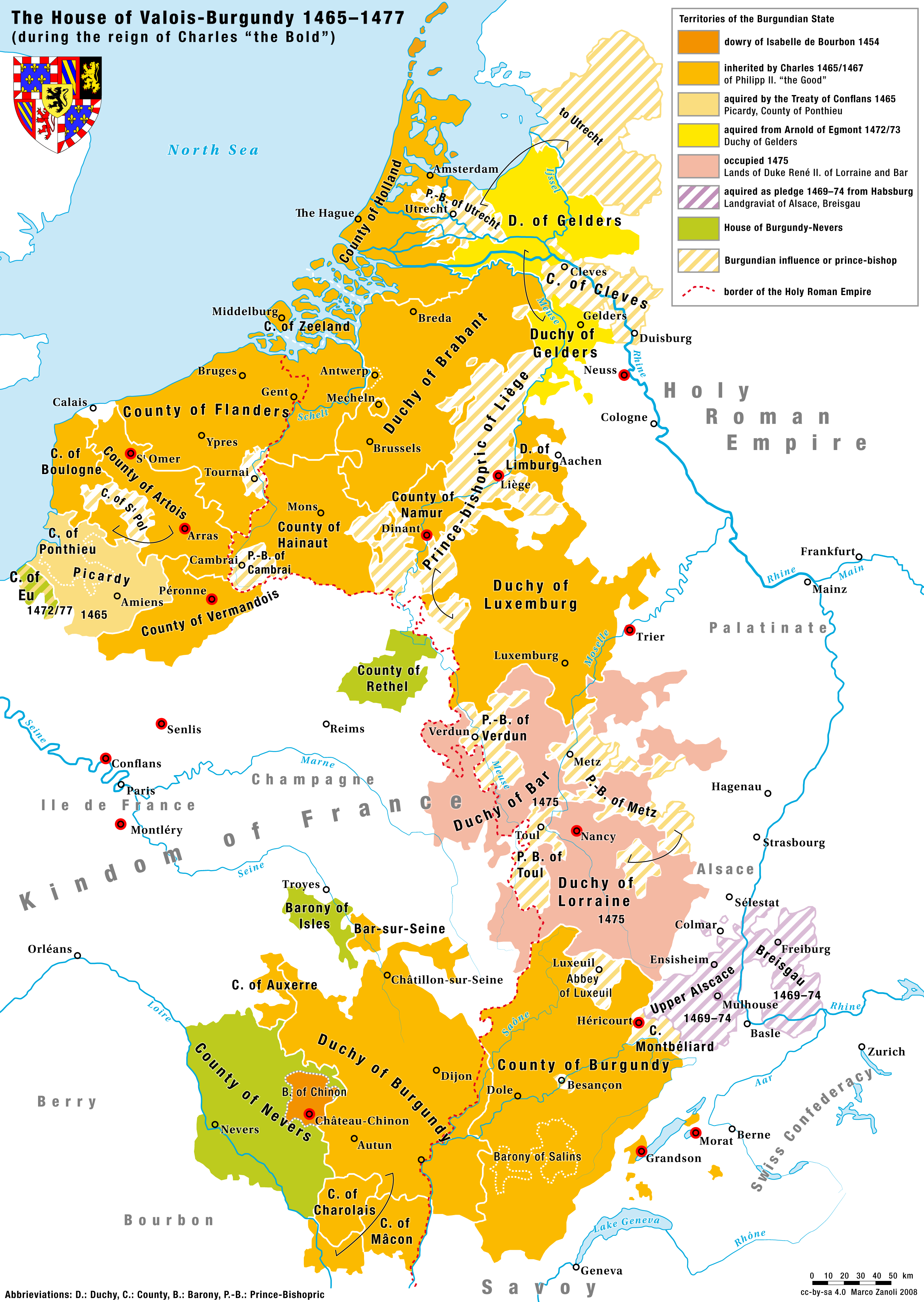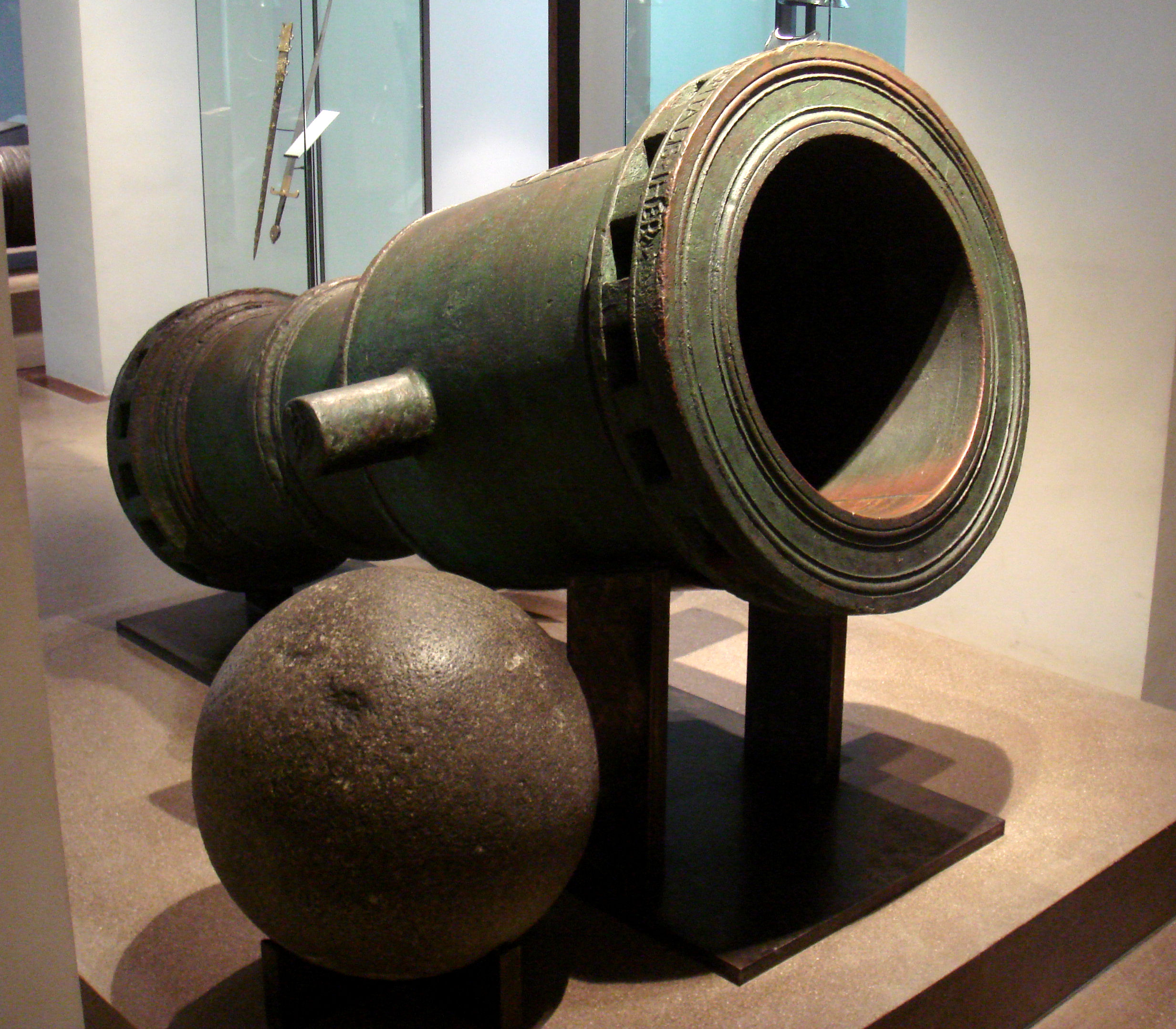|
Battle Of Morat
The Battle of Morat (also known as the Battle of Murten) was a battle in the Burgundian Wars (1474–77) that was fought on 22 June 1476 between Charles the Bold, the Duke of Burgundy, and a Swiss Confederate army at Morat/Murten, about 30 kilometres from Bern. The result was a crushing defeat for the Burgundians at the hands of the Swiss. Background Stung by his defeat by the Swiss Confederation at Grandson in March 1476, Charles the Bold, Duke of Burgundy, reorganised his tangled but otherwise mainly intact army at Lausanne. By the end of May he once again felt ready to march against the Confederates to recover his territories and fortifications in the Pays de Vaud, then march on and attack the city of Berne, his greatest enemy among the Swiss cantons. His first objective was the strategic lakeside town of Morat, set on the eastern shore of Lake Morat. On 11 June 1476, the Burgundians commenced the siege of the well-prepared town, whose forces were commanded by the Bernes ... [...More Info...] [...Related Items...] OR: [Wikipedia] [Google] [Baidu] |
Burgundian Wars
The Burgundian Wars (1474–1477) were a conflict between the Burgundian State and the Old Swiss Confederacy and its allies. Open war broke out in 1474, and the Duke of Burgundy, Charles the Bold, was defeated three times on the battlefield in the following years and was killed at the Battle of Nancy in 1477. The Duchy of Burgundy and several other Burgundian lands then became part of France, and the Burgundian Netherlands and Franche-Comté were inherited by Charles's daughter, Mary of Burgundy, and eventually passed to the House of Habsburg upon her death because of her marriage to Maximilian I, Holy Roman Emperor. Background The House of Valois#List of Valois Dukes and Duchesses of Burgundy, dukes of Burgundy had succeeded, over a period of about 100 years, in establishing their rule as a strong force between the Holy Roman Empire and France. The consolidation of regional principalities with varying wealth into the Burgundian State brought great economic opportunity and wealth ... [...More Info...] [...Related Items...] OR: [Wikipedia] [Google] [Baidu] |
Bombard (weapon)
The bombard is a type of cannon or mortar which was used throughout the Middle Ages and the early modern period. Bombards were mainly large calibre, muzzle-loading artillery pieces used during sieges to shoot round stone projectiles at the walls of enemy fortifications, enabling troops to break in. Most bombards were made of iron and used gunpowder to launch the projectiles. There are many examples of bombards, including Mons Meg, the Dardanelles Gun, and the handheld bombard. The weapon provided the name to the Royal Artillery rank of bombardier and the word bombardment. Terminology The term "bombard" was first used to describe guns of any kind from the early to mid-14th century, but it was later applied primarily to large cannons during the 14th to 15th centuries. Despite its strong association with large cannons, there is no standard size for bombards, and the term has been applied to cannons only a meter in length as well as cannons several meters long weighing up to ... [...More Info...] [...Related Items...] OR: [Wikipedia] [Google] [Baidu] |
Edmund Beaufort, 4th Duke Of Somerset
Edmund Beaufort (c. 1438 – 6 May 1471), styled 4th Duke of Somerset, 6th Earl of Somerset, 3rd Marquess of Dorset, 3rd Earl of Dorset, was an English nobleman, and a military commander during the Wars of the Roses, in which he supported the Lancastrian king Henry VI. Life Edmund Beaufort, born about 1438, was the second son of Edmund Beaufort, 2nd Duke of Somerset by his wife Eleanor de Beauchamp, a daughter of Richard Beauchamp, 13th Earl of Warwick and widow of Thomas de Roos, 14th Baron Roos of Hamlake. His elder brother was Henry Beaufort, 3rd Duke of Somerset (26 January 1436 – 15 May 1464). After the defeat of the Lancastrians in 1461, Edmund was brought up in France with his younger brother John Beaufort, Marquess of Dorset, and on the execution of his elder brother Henry Beaufort, 3rd Duke of Somerset after the Battle of Hexham in 1464, Edmund is said to have succeeded as 4th Duke of Somerset by Lancastrians in February 1471, though his brother's attainder was ne ... [...More Info...] [...Related Items...] OR: [Wikipedia] [Google] [Baidu] |
Duke Of Somerset
Duke is a male title either of a monarch ruling over a duchy, or of a member of royalty, or nobility. As rulers, dukes are ranked below emperors, kings, grand princes, grand dukes, and sovereign princes. As royalty or nobility, they are ranked below princess nobility and grand dukes. The title comes from French ''duc'', itself from the Latin '' dux'', 'leader', a term used in republican Rome to refer to a military commander without an official rank (particularly one of Germanic or Celtic origin), and later coming to mean the leading military commander of a province. In most countries, the word ''duchess'' is the female equivalent. Following the reforms of the emperor Diocletian (which separated the civilian and military administrations of the Roman provinces), a ''dux'' became the military commander in each province. The title ''dux'', Hellenised to ''doux'', survived in the Eastern Roman Empire where it continued in several contexts, signifying a rank equivalent to a ca ... [...More Info...] [...Related Items...] OR: [Wikipedia] [Google] [Baidu] |
René II, Duke Of Lorraine
René II (2 May 1451 – 10 December 1508) was Count of Vaudémont from 1470, Duke of Lorraine from 1473, and Duke of Bar from 1483 to 1508. He claimed the crown of the Kingdom of Naples and the County of Provence as the Duke of Calabria 1480–1493 and as King of Naples and Jerusalem 1493–1508. He succeeded his uncle John of Vaudémont as Count of Harcourt in 1473, exchanging it for the county of Aumale in 1495. He succeeded as Count of Guise in 1504. Life René was born in Angers, the son of Yolande of Lorraine and Frederick, Count of Vaudémont. He spent his youth in the court of his grandfather René I of Anjou between Angers and Provence. René succeeded his father in Vaudémont in 1470 and, three years later, his uncle as captain of Angers, seneschal and governor of Anjou. That same year he became Duke of Lorraine, which was at the time under the pressure of both Louis XI of France and Charles the Bold of Burgundy, with whom he initially allied. When the lat ... [...More Info...] [...Related Items...] OR: [Wikipedia] [Google] [Baidu] |
Bois Du Domingue
Bois may refer to: * Bois, Charente-Maritime, France * Bois, West Virginia, United States * Bois d'Arc, Texas, United States * Les Bois, Switzerland * Landskrona BoIS, a Swedish professional football club * Tranås BoIS, a Swedish sports club People with the surname Bois * Cécile Bois (born 1971), French actress * Curt Bois (1901–1991), German actor * Désiré Georges Jean Marie Bois (1856–1946), French botanist * Guy Bois (1934–2019), French historian * John Bois (1560–1643), English scholar * Jon Bois (born 1982), American sportswriter * Mathieu Bois (born 1988), Canadian swimmer * Rob du Bois (1934–2013), Dutch composer and jurist See also * * * Boise (other) * Boy (other) * Dubois (other) * Grand Bois (other) * Petit Bois (other) Petit Bois is a community in the Ouest department of Haiti. Petit Bois or Petit-Bois can also refer to: * Petit Bois Island, island in Mississippi, United States * Petit-Bois Stadium ... [...More Info...] [...Related Items...] OR: [Wikipedia] [Google] [Baidu] |
Skirmishers
Skirmishers are light infantry or light cavalry soldiers deployed as a vanguard, flank guard or rearguard to screen a tactical position or a larger body of friendly troops from enemy advances. They are usually deployed in a skirmish line, an irregular open formation that is much more spread out in depth and in breadth than a traditional line formation. Their purpose is to harass the enemy by engaging them in only light or sporadic combat to delay their movement, disrupt their attack, or weaken their morale. Such tactics are collectively called skirmishing. A battle with only light, relatively indecisive combat is often called a skirmish even if heavier troops are sometimes involved. Skirmishers can be either regular army units that are temporarily detached to perform skirmishing or specialty units that are specifically armed and trained for such low-level irregular warfare tactics. Light infantry, light cavalry, and irregular units often specialize in skirmishing. Skirmish ... [...More Info...] [...Related Items...] OR: [Wikipedia] [Google] [Baidu] |
Schilling Battle Morat
{{disambiguation ...
Schilling may refer to: * Schilling (unit), an historical unit of measurement * Schilling (coin), the historical European coin * Austrian schilling, the former currency of Austria * A. Schilling & Company, an historical West Coast spice firm acquired in 1948 by McCormick & Company * Schilling Air Force Base * Schilling Power Station, an oil-fired power station near the nuclear power station at Stade, Germany * Schilling of Solothurn, a family of two Swiss chroniclers * The Schilling School for Gifted Children, a K-12 school in Cincinnati, Ohio People * Schilling (surname) See also * Schilling test in medicine * Shilling * Schillings, a firm of UK lawyers * Schillings (surname) * Skilling (currency) The skilling (pronounced ''shilling'' in English) was the Scandinavian equivalent of the shilling. It was used as a subdivision of the various kinds of currencies named rigsdaler in use throughout Scandinavia, including the Danish rigsdaler, the ... [...More Info...] [...Related Items...] OR: [Wikipedia] [Google] [Baidu] |
Gendarme (historical)
A ''gendarme'' was a heavy cavalryman of noble birth, primarily serving in the French army from the Late Middle Ages to the Early Modern period. Heirs to the knights of French medieval feudal armies, French Gendarmes also enjoyed a stellar reputation and were regarded as the finest European heavy cavalry force until the decline of chivalric ideals largely due to the ever-evolving developments in gunpowder technology. They provided the Kings of France with a potent regular force of armored lancers which, when properly employed, dominated late medieval and early modern battlefields. Their symbolic demise is generally considered to be the Battle of Pavia, which inversely is seen as confirming the rise of the Spanish Tercios as the new dominant military force in Europe. Etymology The word ''gendarme'' derives originally from the French ''homme d'armes'' (man-at-arms), plural of which is ''gens d'armes''. The plural sense was later shortened to ''gendarmes'' and a singular made ... [...More Info...] [...Related Items...] OR: [Wikipedia] [Google] [Baidu] |
Halberd
A halberd (also called halbard, halbert or Swiss voulge) is a two-handed pole weapon that came to prominent use during the 13th, 14th, 15th, and 16th centuries. The word ''halberd'' is cognate with the German word ''Hellebarde'', deriving from Middle High German ''halm'' (handle) and ''barte'' (battleaxe) joined to form ''helmbarte''. Troops that used the weapon were called halberdiers. The halberd consists of an axe blade topped with a spike mounted on a long shaft. It always has a hook or thorn on the back side of the axe blade for grappling mounted combatants. It is very similar to certain forms of the voulge in design and usage. The halberd was usually 1.5 to 1.8 metres (5 to 6 feet) long. The word has also been used to describe a weapon of the Early Bronze Age in Western Europe. This consisted of a blade mounted on a pole at a right angle. History The halberd was inexpensive to produce and very versatile in battle. As the halberd was eventually refined, its point was m ... [...More Info...] [...Related Items...] OR: [Wikipedia] [Google] [Baidu] |





.jpg)